
Medical Provincial Affiliated Academic
Campus Technology (MPAACT)

In 2002, the University of British Columbia received the mandate from the Provincial Government of BC to expand the Faculty of Medicine Medical School Program to the University of Victoria located on Vancouver Island and the University of Northern BC in Prince George. As in many parts of the modern world, British Columbia has been experiencing a shortage of medical doctors in the rural areas of the province, while an abundance of doctors has been living and practicing in the greater Metropolitan area of Vancouver. The Ministry of Health soon realized that the only suitable way to get doctors to relocate the rural areas of BC, was to educate and train them in these areas. As it would have been cost prohibitive to create separate medical schools at UVic and UNBC, as well as being impossible to find and recruit the required experienced teaching talent to create separate medical faculties in each region, the decision was made to expand the UBC, FoM medical program to UVic and UNBC. The intention was to use existing instructor talent at UBC teaching via distance education technology to deliver lectures, lab sessions, problem based learning sessions, academic rounds and everything else required for the delivery of the curriculum for year 1 & 2 of the MD undergraduate program to the students participating at the new Island Medical Program facility scheduled to be built at UVic and the Northern Medical Program planned for UNBC.
Central to the Expansion Program is the distributed learning model (or distance education), where lectures and labs are delivered both to students in the same physical location as the lecturer, and simultaneously to students at multiple remote locations. The lectures will be viewed by all students in the remote locations in real time, and will be configured so as to mimic as closely as possible the traditional classroom experience for all students, both at the local and remote sites.
In 2003 the University of British Columbia asked McSquared in their capacity as AV system design consultant to develop the Performance standard guidelines, develop the infrastructure and room criteria design and design the AV technology systems required to provide the ability to educate medical students located at the new remote locations at UNBC and UVic, from the to be built Life Sciences Centre at UBC in Vancouver.
Working closely with the Associate Director of Technology, the Project Director, the inter-university project team, as well as the Faculty of Medicine Curriculum committee McSquared developed the functional requirement for the distance education technology systems. Based on the validated technical functional requirements McSquared then developed the 'A/V systems functional & Performance Standard Guidelines document' creating a common platform to work from for the design of all distance education enabled A/V systems planned for the Lecture theatres, the multi-purpose labs, the Gross anatomy labs, as well as the curriculum planning rooms.
After performing a series of tests and conducting a prototypical week delivering actual classes to the three sites using temporarily setup A/V systems the functional requirements were confirmed and the green light was given to proceed with the design of the A/V systems. Working with the architects, electrical and mechanical engineers McSquared provided the acoustical, lighting, architectural and mechanical criteria required to create room environments suitable to accommodate and support sophisticated distance education enabled A/V systems.
It was critical to create suitable room acoustics so the participants at all sits to be able to hear and understand the instructor as well as interact with the remote sites. Setting adequate lighting levels was equally important to provide to allow video images of the instructor or any specimens to be transmitted with proper quality and adequate color reproduction. Designing the rooms to create for proper viewing distances and angles is another important criterion to allow for all students in the room, even the most distant viewer in the back row, to comfortably read the information displayed on the screens.
After the new facilities, classrooms, Network connectivity and distance education enabled A/V systems had been implemented, tested and inter-site commissioned, teaching of a new generation of doctors began in the fall of 2004, with 24 students attending at each at IMP and NMP.
In 2005 the Ministry of Health launched the Medical Provincial Affiliated Academic Campus Technology (MPAACT) initiative, The goal of the initiative was to create new academic spaces within the clinical campuses around the province to specifically support the academic component of the distributed clinical education in undergraduate and post graduate programs, in the same way that the three LSC, IMP and NMP buildings at UBC, UVic and UNBC campuses support the academic requirements of the MD undergraduate program, enabling placement of students in distributed campuses.
The clinical academic campuses, located at teaching hospital throughout BC have been built in 2006 as part of phase-one of the MPAACT program, and will each have at least one 35- 40 seat Large Seminar Room equipped with a permanently installed A/V Presentation, Sound and Video Conferencing based distance education system. The DHCC clinical academic campus located in Vancouver, and also built as part of phase one of the MPAACT program, has three 35- 40 seat Large Seminar Rooms, each equipped with a permanently installed A/V Presentation, Sound and Video Conferencing based distance education system. Additionally the DHCC located at the Vancouver Hospital campus also has a central AV-room system providing AV systems support and monitoring capabilities.
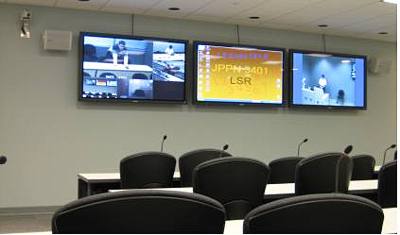
The Large Seminar Rooms each are equipped with a permanently installed A/V Presentation, Sound and Video Conferencing based distance education system. Each A/V system in these Large Seminar Rooms consists of three side by side 65 " flat screens for the simultaneous display of video, document camera, computer based digital slides, computer presentation, computer based X-ray as well as image/sources from the remote locations.
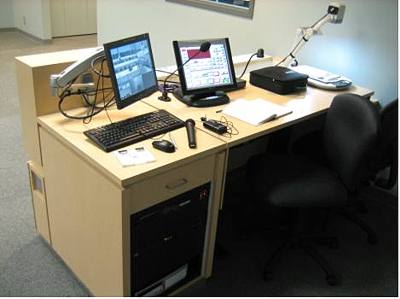
The permanently installed lecterns in the Large Seminar Rooms are the main system control point providing housing for the DVD/VCR combo unit, the computer interface, the control touch screen as well as the document camera. The lecterns is also be equipped with an articulated arm mount 18" LCD touch screen monitor, which serves as preview and RGB signal confidence monitor as well as the "write on" surface providing electronic annotation capabilities. This provides the presenter with the ability to make annotation on top of the computer-generated image displayed on the local as well as the remote location screens.
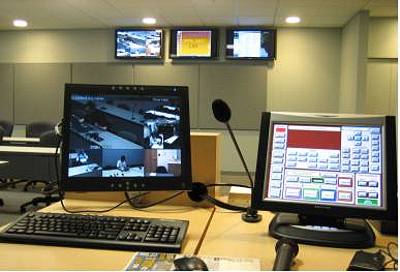
Three 37" back wall mount preview/confidence monitors each provide the instructors with the ability to see the same sources as are displayed on the main screens.
The audio system is split into two elements, an AV playback system supporting the playback of multimedia material from various sources, as well as the incoming audio from the videoconferencing based distance education system. The audio system has a local wired lectern microphone and two wireless instructor microphones to accommodate a variety of presentation styles. The audience seating areas are equipped with push-to-talk microphones, one for each pair of students. The student microphones are gooseneck type microphones, permanently mounted to the audience area fixed tables. A speech reinforcement system is used for delivery of voice program to the seating area during lectures. The AV playback system uses loudspeakers associated with the large screen displays located on the front wall and the speech system makes use of ceiling mounted loudspeakers.
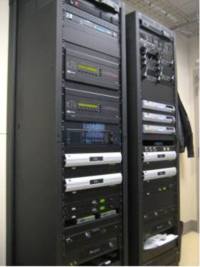 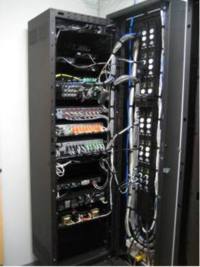
The centre-piece of the audio system is a centralized Digital Signal Processor based matrix mixer/router system that allows all the various microphone and AV source inputs to be sent to the appropriate signal paths with suitable signal processing. Microphones are mixed for delivery in the room using an auto-mixer to manage feedback, and simultaneously are mixed and processed with SAGC (Smart Automatic Gain Control) and digital echo-canceling for the video conference feed, and separately mixed and processed for archiving/streaming. The AV source inputs are routed to the AV playback speakers, video conference sends and archival feeds as required. The DSP also handles equalization, signal delays, compression, limiting, level adjustment and other required audio functions.
The RGBH/V and the composite video signals are routed through two separate video matrix switchers, controlled via the AV remote control system. By using matrix switchers, the video routing system is capable of handle all current and future video signal routing needs, while the matrix switching allows for any incoming signal to be routed to any or all of the router outputs, providing the greatest system flexibility. Both the video and the RGB matrix switchers feed the display devices with the switching between computer and composite video formats being executed at the display level through the remote control system touch panel. The matrix switchers provide preset configurations for various different preset functions such as local classes and distance education, and will be recalled automatically by the AV control system once the user has selected the system use from the touch panel.
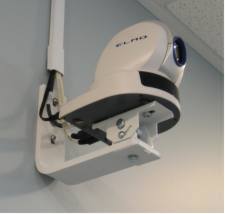 Two wall mount robotic video conferencing cameras are setup for preset shots and positions, and can also be manually controlled through the remote control interface on the touch screen. One compact motorized zoom/pan/tilt video camera is located at the front wall next to the large screen displays to capture the image of the entire audience, with a camera preset for each of the twenty audience microphones, providing a head shot of the person talking. A second camera captures the instructor, allowing the audience at the far end of the distance education session to see the face of the instructor. Two wall mount robotic video conferencing cameras are setup for preset shots and positions, and can also be manually controlled through the remote control interface on the touch screen. One compact motorized zoom/pan/tilt video camera is located at the front wall next to the large screen displays to capture the image of the entire audience, with a camera preset for each of the twenty audience microphones, providing a head shot of the person talking. A second camera captures the instructor, allowing the audience at the far end of the distance education session to see the face of the instructor.
The equipment racks as well as the AV operator desk are located in the centralized AV control room, providing adequate working space for the AV systems operator.
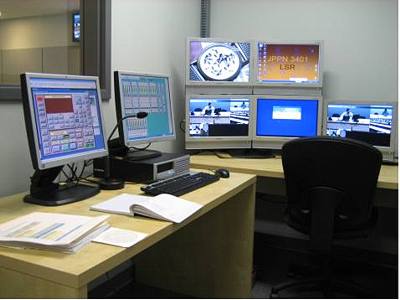
The AV operator desk is equipped with the required network and AV connections as well as the necessary displays to provide the operator with the ability to operate and monitor the AV systems in the classroom from the AV control room location using the AV control system network control interface.
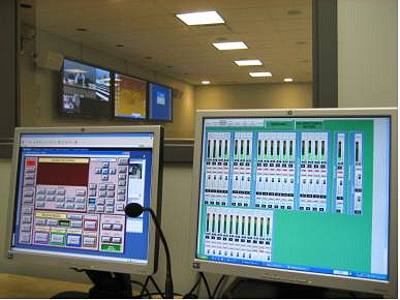
The AV control system integrates the function of the many devices in the Large Seminar Room presentation & sound systems as well as the video conferencing systems. All of the necessary controls are hooked to this central processor allowing them all to be controlled from 15" color control touch panels located on the lecterns, or through the AV control room based operators computer connected to the LAN using the control system web interface.
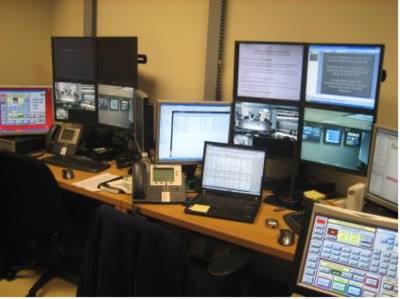
The operator control panel allows the AV operator to control the AV system in the background assisting the instructor in operation of the AV system, independently from the instructors touch screen control panel.
For the purpose of connecting to the remote sites, the large seminar rooms are equipped with videoconferencing based distance education capability, allowing for the simultaneous transmission of up to three video and high resolution graphics channels. This is accomplished by using one videoconferencing CODEC as well as using the data link of the KVM VNC server collaboration application.
By creating a private protected VC network, connected over a fiber backbone enabled the distributed medical program to use a distributed videoconferencing hosting model making use of the multi-site hosting capabilities of the Videoconferencing CODEC's, instead of using a centralized hosting model, requiring the use of two, one for back up purposes, expensive videoconferencing hosting bridges.
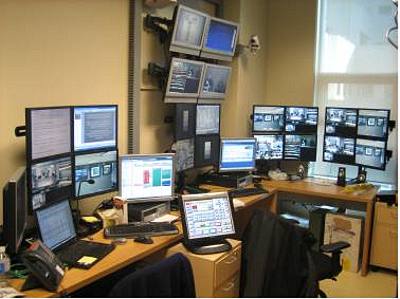
Picture shows the Vancouver Hospital Diamond Health Care Centre Central AV control room, controlling up to 7 fully distance education enabled classrooms.
In addition to the 30- 45 seat large seminar rooms, a 250-seat lecture theatre was built at the Vancouver Hospital campus in the fall of 2006 as part of phase one of the MPAACT program. This lecture theatre has also been equipped with a permanently installed A/V Presentation, Sound and Video Conferencing based distance education system.
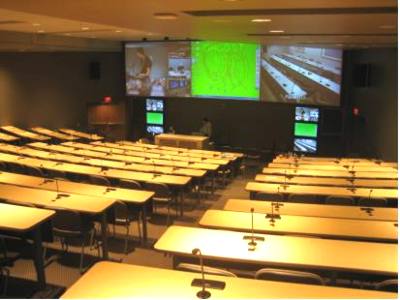
The A/V system in this Lecture Theatre consists of three side by side, 11' (3341mm) wide projected images for the simultaneous display of video, document camera, computer based digital slides, computer presentation, computer based X-ray as well as video image/sources from the remote locations. The centralized A/V control room located at the back of the lecture theatre accommodates the main A/V equipment racks, one remote controlled camera, three LCD based video/data projectors and provide room for an operator position.
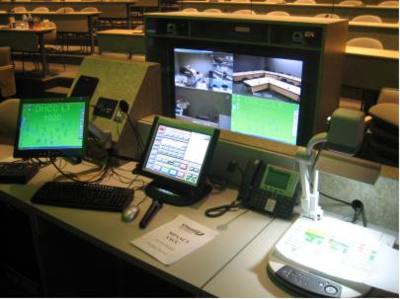
The permanently installed lectern in this Lecture Theatre in the main system control point providing housing for the DVD/VCR combo unit, the computer interface, the control touch screen as well as the document camera. The lecterns is also equipped with an articulated arm mount 18" LCD touch screen monitor. Additionally, the Lecture Theatre has been equipped with one 65" millwork mount preview/confidence monitor using a video quad-splitter to display four 32" wide images providing the instructor with the ability to see the same sources as are displayed on the main screens.
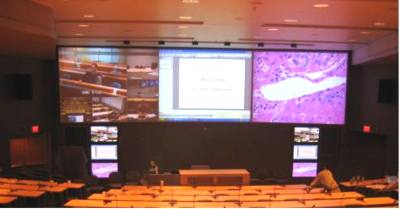
The front wall has also been equipped with six 42" plasma displays, 3 located on the left side and the right side of the wall mount blackboard, displaying the same images as the main screens. The purpose of these additional displays is to provide visual coverage for the front and second row of the audience area, as these row are too close for the people seated in row one and two to view the images displayed on the main projection screens.
Similar to the large seminar room AV systems the audio system in the lecture theatre has been split into two elements, an AV playback system that supports the playback of multimedia material from various sources, as well as supporting the incoming audio from the videoconferencing based distance education system. The audience seating area has been equipped with 118 PTT (push-to-talk) microphones, one for each pair of students.
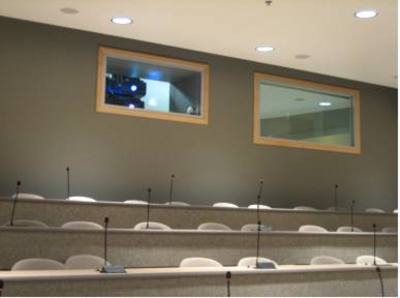
The student microphones are gooseneck type microphones, permanently mounted to the audience area fixed tables. Audience seats without tables make use of one of six wireless student microphones. A speech reinforcement system is used for delivery of voice program to the seating area during lectures. The AV playback system uses loudspeakers associated with the large screen displays located on the front wall and the speech system uses ceiling mounted loudspeakers. A loudspeaker in mounted in the lectern will reinforce student mics and remote (CODEC/Telephone) audio for the instructor.
The sound system uses two banks of DSP-based matrix mixer/router systems. A bank of five DSP units processes the 118 student microphones with acoustic echo cancellation on each microphone and installed in a technical room beneath the seating area. A second bank of two DSP units combine the student microphone signals with the balance of the microphone and line input signals and provide a gain/switch-matrix to route the signals and provide comprehensive signal processing. The wired lectern microphones is gain-managed (ducking) to reduce feedback and wireless/wired microphone interaction. All microphones are mixed and processed with SAGC (Smart Automatic Gain Control) and digital echo-canceling for the video conference feed, and separately mixed and processed for archiving/streaming.
The student microphones include switching logic to limit the maximum number of microphones open simultaneously to three. When a forth student microphone (or more) PTT switch is pressed, the microphone LED does not illuminated and the microphone will remain muted until fewer than three PTT switches are pressed simultaneously. The AV source inputs are routed to the AV playback speakers, video conference sends and archival feeds as required. The DSP also handles equalization, signal delays, compression, limiting, level adjustment and other required audio functions.
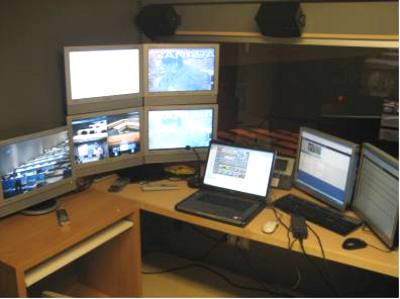
The control system integrates the function of the many devices in the lecture theatre presentation & sound system as well as the video conferencing system. All of the necessary controls are hooked to this central processor allowing them all to be controlled from 15" color control touch panel located on the lectern, or by the operator computer located in the lecture theater AV control room and connected to the LAN using the control system web interface.
For the purpose of connecting to the remote sites, the lecture theatre has also be equipped with videoconferencing based distance education capability, allowing for the simultaneous transmission of up to three video and high resolution graphics channels. The videoconferencing system uses a total of five remote controlled motorized pan/tilt & zoom/focus video cameras located throughout the lecture theatre.
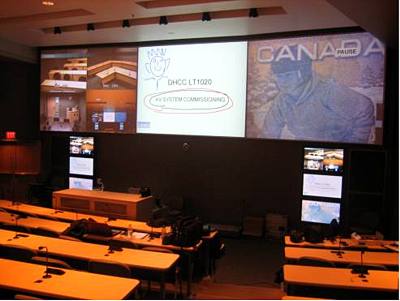
Reference Letter from UBC Faculty of Medicine
The UBC project is also an award winner, the Ted Freedman Award and the COACH Best Innovation in Technology Award
Awards Letter from UBC Faculty of Medicine
|


